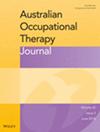Occupational therapy experiences of interprofessional collaboration in the support of autistic children
Abstract
Introduction
Autistic children commonly receive simultaneous services from various health-care and other professionals, including occupational therapy, throughout their journey of diagnosis and consequent therapeutic support. Current best practice guidelines for supporting autistic youth emphasise the importance of interprofessional collaboration. Despite this, collaboration among health-care professionals does not always occur, and little is understood about clinicians' experiences of collaborative care. The aim of this study was to explore Australian paediatric occupational therapists' experiences of interprofessional collaboration and their perception of factors influencing collaboration when supporting autistic children.
Methods
This study employed an exploratory qualitative descriptive design. Semi-structured interviews were conducted with 13 Australian paediatric occupational therapists involved in service provision to autistic children. Questions explored clinicians' experiences and perceptions of interprofessional collaboration. Reflexive thematic analysis was used to inductively analyse data.
Consumer and Community Consultation
This study was conceptualised and conducted by a team of researchers with a range of personal and professional experiences with the autistic community. The research design was strongly informed by the Autism CRC'S research guidelines.
Findings
Three themes were generated highlighting factors that influence collaboration between occupational therapists and other professionals. The first emphasised that ‘clinicians' capacity to collaborate’ at both organisational and individual levels was understood to be greatly influenced by funding structures. The second emphasised that ‘relationships are key to collaboration’ with these often established through shared workplaces or clients. The third, ‘shared perceptions make collaboration easier’ described how shared perceptions of collaboration, the occupational therapy role, and autism-related frames of reference were perceived to influence interprofessional collaboration.
Conclusion
Findings indicate that, while occupational therapists perceive interprofessional collaboration as valuable in the support of autistic children, there are barriers to effective collaboration, particularly in the context of a marketised service delivery model.
PLAIN LANGUAGE SUMMARY
This study looked at how Australian occupational therapists work with other professionals to support autistic children. Even though it is recommended that professionals work together to support autistic children and their families, this does not always happen. In this study, researchers interviewed 13 occupational therapists and asked what it is like working with other professionals, what is helpful, and what makes working together difficult. From these interviews, it was found that many things affect how well occupational therapists can work with other health professionals and teachers to support autistic children. Factors like funding and workplace rules affect how professionals work together. Having someone take on the role of leader and having good relationships between professionals made it easier to work together. It was also helpful when occupational therapists and other professionals shared similar ideas on how to support autistic children. The study could be improved if it had gathered more information about the occupational therapists' education and what they have learnt about working with other professionals. Overall, the therapists in this study believed that working together to support autistic children and their families was important, but that there are many challenges to making this happen. More research on this topic would be helpful.

 求助内容:
求助内容: 应助结果提醒方式:
应助结果提醒方式:


